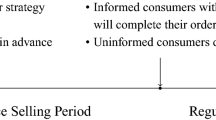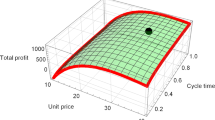Abstract
Motivated by the emerging practices of China's major e-commerce platforms, we investigate the effect of consumer’s valuation change, deposit expansion and return policy on retailer’s advance booking decisions. We establish the retailer’s expected profit based on a two-stage newsvendor model and derive his optimal deposit and order quantity decisions under different scenarios. Our conclusions show that: (1) the retailer gains further profit under the advance selling strategy with a deposit, due to the reduction of inventory risk and exploitation of consumer’s valuation uncertainty; (2) the retailer benefits more from advance selling when he has a lower profit margin or the consumers have low-level prior valuations; (3) the effectiveness of advance selling on exploiting consumer’s valuation uncertainty will be weakened if the retailer allows customers to return products; (4) a lower deposit expansion rate leads to higher deposit and expected profit.








Similar content being viewed by others
References
Cheng YS, LiThorstenson HYA (2018) Advance selling with double marketing efforts in a newsvendor framework. Comput Ind Eng 118:352–365
Chiang WK, Chhajed D, Hess JD (2003) Direct marketing, indirect profits: a strategic analysis of dual-channel supply-chain design. Manag Sci 49(1):1–20
DeGraba P (1995) Buying frenzies and seller-induced excess demand. RAND J Econ 26(2):331–342
Huang KL, Kuo CW, Shih HJ (2017) Advance selling with freebies and limited production capacity. Omega 73:18–28
Khouja M, Zhou J (2015) Channel and pricing decisions in a supply chain with advance selling of gift cards. Eur J Oper Res 244(2):471–489
Kuthambalayan TS, Mehta P, Shanker K (2015) Managing product variety with advance selling and capacity restrictions. Int J Prod Econ 170:287–296
Li C, Zhang F (2012) Advance demand information, price discrimination, and pre-order strategies. Manuf Serv Oper Manag 15(1):57–71
Lim WS, Tang CS (2013) Advance selling in the presence of speculators and forward-looking consumers. Prod Oper Manag 22(3):571–587
Mccardle K, Rajaram K, Tang CS (2004) Advance booking discount programs under retail competition. Manag Sci 50(5):701–708
Moe WW, Fader PS (2002) Using advance purchase orders to forecast new product sales. Marketing Sci 21(3):347–364
Mukherjee A, Jha S, Smith RJ (2017) Regular price $299; pre-order price $199: price promotion for a pre-ordered product and the moderating role of temporal orientation. J Retail 93(2):201–211
Nasiry J, Popescu I (2012) Advance selling when consumers regret. Manag Sci 58(6):1160–1177
Prasad A, Stecke KE, Zhao X (2011) Advance selling by a newsvendor retailer. Prod Oper Manag 20(1):129–142
Shugan SM, Xie JH (2000) Advance pricing of services and other implications of seperating purchase and consumption. J Serv Res 2(2–3):227–239
Shugan SM, Xie JH (2004) Advance selling for services. Calif Manag Rev 46(3):37–54
Tang CS, Rajaram K, Alptekinoglu A, Ou J (2004) The benefits of advance booking discount programs: model and analysis. Manag Sci 50(4):465–478
Tian ZJ, Wang YF (2016) Advance selling with preorder-dependent customer valuation. Res Lett 44:557–562
Wei MM, Zhang F (2018) Advance selling to strategic consumers: preorder contingent production strategy with advance selling target. Prod Oper Manag 27:1221–1235
Xie J, Shugan SM (2001) Electronic tickets, smart cards, and online prepayments: when and how to advance sell. Market Sci 20(3):219–243
Yu M, Ahn HS, Kapuscinski R (2015a) Rationing capacity in advance selling to signal quality. Manag Sci 61(3):560–577
Yu M, Kapuscinski R, Ahn H (2015b) Advance selling with interdependent customer valuations. Manag Sci 61(9):2100–2117
Zhang QH, Zhang DL, Segerstedt A, Luo JW (2018) Optimal ordering and pricing decisions for a company issuing product-specific gift cards. Omega 74:92–102
Zhao XY, Stecke KE (2010) Pre-orders for new to-be-released products considering consumer loss aversion. Prod Oper Manag 19(2):198–215
Zhao XY, Pang Z, Stecke KE (2016) When does a retailer’s advance selling capability benefit manufacturer, retailer, or both? Prod Oper Manag 25(6):1073–1087
Acknowledgements
The authors thank the anonymous referees for their helpful comments and suggestions. This research is supported in part by National Natural Science Foundation of China (71771146). This paper is also a part of the project funded by Shanghai Pujiang Talent Project (16PJC059).
Author information
Authors and Affiliations
Corresponding author
Additional information
Publisher's Note
Springer Nature remains neutral with regard to jurisdictional claims in published maps and institutional affiliations.
Appendices
Appendix
Proof of Proposition 1
If \(0\le b<\frac{p-\overline{{v }_{0}}+M}{2}\) (Case III), we have \({D}_{c}-{D}_{r}=-\frac{{N}_{1}{\left(2b-M-p+\overline{{v }_{0}}\right)}^{2}}{4\overline{{v }_{0}}M}<0\). Hence, we have \({D}_{c}<{D}_{r}\). For case I and case II, Table 2 shows that \({D}_{c}={D}_{r}\).
Proof of Lemma 1
Since \({\pi }_{2}^{I}\left(\left.{Q}^{I}\right|{N}_{1},b\right)=\left(p-w\right){Q}^{I}-\frac{p\left(\overline{{v }_{0}}-p\right)}{\overline{{v }_{0}}}{\int }_{0}^{\frac{\overline{{v }_{0}}{Q}^{I}}{\overline{{v }_{0}}-p}}\Phi \left(n\right)dn+\frac{{N}_{1}\left(p-2b-w\right)\left(\overline{{v }_{0}}-p+b\right)}{\overline{{v }_{0}}}\), then the first order and the second order with respect to \({Q}^{I}\) are \(\frac{d{\pi }_{2}^{I}\left(\left.{Q}^{I}\right|{N}_{1},b\right)}{d{Q}^{I}}=p-w-p\Phi \left(\frac{\overline{{v }_{0}}{Q}^{I}}{\overline{{v }_{0}}-p}\right),\) and \(\frac{{d}^{2}{\pi }_{2}^{I}\left(\left.{Q}^{I}\right|{N}_{1},b\right)}{d{{Q}^{I}}^{2}}=-\frac{\overline{{v }_{0}}p}{\overline{{v }_{0}}-p}\phi \left(\frac{\overline{{v }_{0}}{Q}^{I}}{\overline{{v }_{0}}-p}\right)<0,\) respectively. Therefore, \({\pi }_{2}^{I}\left(\left.{Q}^{I}\right|{N}_{1},b\right)\) is a concave function of \({Q}^{I}\) and the optimal order quantity is \({Q}^{I}=\frac{\overline{{v }_{0}}-p}{\overline{{v }_{0}}}{\Phi }^{-1}\left(\frac{p-w}{p}\right).\) Hence, the total order quantity, \({Q}^{I}+\frac{{N}_{1}(\overline{{v }_{0}}-p+b)}{\overline{{v }_{0}}}\), is \(\frac{\overline{{v }_{0}}-p}{\overline{{v }_{0}}}{\Phi }^{-1}\left(\frac{p-w}{p}\right)+\frac{{N}_{1}(\overline{{v }_{0}}-p+b)}{\overline{{v }_{0}}}.\)
Proof of Proposition 2
Given \({\pi }_{1}^{I}\left(b|{N}_{1}\right)=\frac{E({N}_{1})(\overline{{v }_{0}}-p+b)(p-b-w)}{\overline{{v }_{0}}}+\left(p-w\right)\frac{\overline{{v }_{0}}-p}{\overline{{v }_{0}}}{\Phi }^{-1}\left(\frac{p-w}{p}\right)-\frac{p\left(\overline{{v }_{0}}-p\right)}{\overline{{v }_{0}}}{\int }_{0}^{\frac{\overline{{v }_{0}}{Q}^{I}}{\overline{{v }_{0}}-p}} \Phi \left(n\right)dn\), then the first order and the second order with respect to \(b\) is
and
respectively. Therefore, the first-order condition is \(b=\frac{2p-w-\overline{{v }_{0}}}{2}.\) If\(\frac{2p-w-\overline{{v }_{0}}}{2}<0\), then \(\frac{d{\pi }_{1}^{I}\left(b\right)}{d b}<0\) for all \(b\ge 0\) which means\({b}^{*}=M\); if\(\frac{2p-w-\overline{{v }_{0}}}{2}\ge 0\), then the optimal deposit is \(b=\frac{2p-w-\overline{{v }_{0}}}{2}.\) Therefore, the optimal booking is \(b_{1}^{*} = \left\{ {\begin{array}{*{20}c} {\frac{{2p - w - \overline{{v_{0} }} }}{2},} & { if\;\frac{{2p - w - \overline{{v_{0} }} }}{2} > M} \\ {M,} & {otherwise} \\ \end{array} } \right..\)
Proof of Lemma 2
The proof is the same as Lemma 1, and we omit it.
Proof of Proposition 3
For case II, differentiate \({\pi }_{1}^{II}\left(b\right)\) with respect to \(b\) yields
Further, we have
which proves the concavity of \({E}_{{N}_{1}}\left[{\pi }_{1}^{II}\left(b\right)\right]\). Hence the first order with respect to \(b\) is the optimal decision. The optimal solution is \(b=\frac{4M}{3}\pm \frac{\sqrt{M(13M-12p+6\overline{{v }_{0}}+6w)}}{3}\). Since \(b<M\) we have
Recall that the optimal value of \(b\) is derived with the condition, \(\frac{p-\overline{{v }_{0}}+M}{2}\le b<M\), the optimal value of \(b\) is
For case III, we have:
It is not determined whether the second-order is less than zero. For the first order with respect to \(b\), we have:
Then the first-order condition is:
We derive the optimal solution by comparing the function value of the first order and the boundary points. That is
where,
Proof of Proposition 5
The proof is similar to Proposition 3. In particular, we can easily derive the retailer’s profit at the first stage is
-
(1)
if \(M\le b\);
$$\underset{b}{\mathit{max}}E\left[{\pi }_{1}^{I}\left(b\right)\right]=\left(p-w\right){Q}_{r}^{I}-\frac{p\left(\overline{{v }_{0}}-p\right)}{\overline{{v }_{0}}}{\int }_{0}^{{\Phi }^{-1}\left(\frac{p-w}{p}\right)} \Phi \left(n\right)dn+\frac{E\left({N}_{1}\right)\left(p-2b-w\right)\left(\overline{{v }_{0}}-p+b\right)}{\overline{{v }_{0}}}+\frac{bE\left({N}_{1}\right)M}{4\overline{{v }_{0}}}.$$ -
(2)
if \(p-\overline{{v }_{0}}+M\le b<M\);
$$ \begin{aligned} \mathop {\max }\limits_{b} E\left[ {\pi_{1}^{II} \left( b \right)} \right] & = \left( {p - w} \right)Q_{r}^{II} - \frac{{p\left( {\overline{{v_{0} }} - p} \right)}}{{\overline{{v_{0} }} }}\mathop \int \limits_{0}^{{{\Phi }^{ - 1} \left( {\frac{p - w}{p}} \right)}} \Phi \left( n \right)dn \\ & \quad + E\left( {N_{1} } \right)\left( {p - 2b - w} \right)\frac{{\left( {\overline{{v_{0} }} - p + b} \right)}}{{\overline{{V_{0} }} }} + \frac{{\left( {p - w} \right)E\left( {N_{1} } \right)\left( {M - b} \right)^{2} }}{{4\overline{{v_{0} }} M}} + \frac{{bE\left( {N_{1} } \right)M}}{{4\overline{{v_{0} }} }}. \\ \end{aligned} $$ -
(3)
if \(0\le b<p-\overline{{v }_{0}}+M\);
$$ \begin{aligned} \mathop {\max }\limits_{b} E\left[ {\pi_{1}^{II} \left( b \right)} \right] & = \left( {p - w} \right)Q_{r}^{II} - \frac{{p\left( {\overline{{v_{0} }} - p} \right)}}{{\overline{{v_{0} }} }}\mathop \int \limits_{0}^{{{\Phi }^{ - 1} \left( {\frac{p - w}{p}} \right)}} \Phi \left( n \right)dn + E\left( {N_{1} } \right)\left( {p - 2b - w} \right)\frac{{\left( {\overline{{v_{0} }} - p + b} \right)}}{{\overline{{V_{0} }} }} \\ & \quad + \frac{{\left( {p - w} \right)E\left( {N_{1} } \right)\left( {M - b} \right)^{2} }}{{4\overline{{v_{0} }} M}} + b \frac{{3\left( {\overline{{v_{0} }} - p + b} \right)^{2} + 2\left( {\overline{{v_{0} }} - p + b} \right)M}}{{4M\overline{{v_{0} }} }} \\ \end{aligned} $$
Solve the above problem yields Proposition 5. Further, for the proof of \({b}_{rI}^{*}<{b}_{I}^{*}\). since \(\frac{2p-w-\overline{{v }_{0}}}{2}>M\), we have \(-\frac{p}{4}+\frac{w}{4}+\frac{M}{16}<\frac{7w-6p-\overline{{v }_{0}}}{32}<0\). Hence, we have \({b}_{rI}^{*}<{b}_{I}^{*}\).
This completes the proof.
Proof of Lemma 4
It is easy to prove that
and \({N}_{1}{(M-\alpha b)}^{2}-{N}_{1}{\left(M-b\right)}^{2}>0,\) when \(0<{\alpha }<1\).
Therefore, we have:
Recall that: \({D}_{c}=\frac{{N}_{1}\left(\overline{{v }_{0}}-p+\alpha b\right)(p-(2+\alpha )b+2M-\overline{{v }_{0}})}{4\overline{{v }_{0}}M}\), \({D}_{r}=\frac{{N}_{1}{(M-\alpha b)}^{2}}{4\overline{{v }_{0}}M}\). Thus, we have \({\mathrm{D}}_{\mathrm{c}}<{\mathrm{D}}_{\mathrm{r}}\).
Proof of Lemma 5
The proof is similar to the proof of Lemma 1, and we omit it.
Proof of Proposition 6
Notice that when \(0<\alpha <1\) & \(b>\frac{M}{\alpha }\) and \({\alpha }\ge 1\) & \(b>M\), from \(\frac{d{\pi }_{1}^{I}}{d\alpha }=0\), \(\frac{d{\pi }_{1}^{I}}{db}=0\), we derive:
When \(0<\alpha <1\) and \(M\le b<\frac{M}{\alpha }\), from \(\frac{d{\pi }_{1}^{I}}{d\alpha }=0\), \(\frac{d{\pi }_{1}^{I}}{db}=0\), we derive:
Thus, under the above cases, the retailer actually jointly decides expansion rate and deposit. Namely, since the optimal final discount \(\alpha b\) is a constant, a lower expansion rate will lead to a higher-level deposit.
Other parts of the proof are similar to the proof of Lemma 1, so we omit it.
Rights and permissions
About this article
Cite this article
Zhang, Q., Cheng, X., Tsao, YC. et al. Advance selling under deposit expansion and consumer’s valuation change. Oper Res Int J 22, 3633–3661 (2022). https://doi.org/10.1007/s12351-021-00676-9
Received:
Revised:
Accepted:
Published:
Issue Date:
DOI: https://doi.org/10.1007/s12351-021-00676-9




